s@lm@n
Oracle
Exam 1z0-060
Upgrade to Oracle Database 12c
Version: 8.6
[ Total Questions: 150 ]
�
Question No : 1
Oracle 1z0-060 : Practice Test
Your multitenant container (CDB) contains two pluggable databases (PDB), HR_PDB and
ACCOUNTS_PDB, both of which use the CDB tablespace. The temp file is called
temp01.tmp.
A user issues a query on a table on one of the PDBs and receives the following error:
ERROR at line 1:
ORA-01565: error in identifying file ‘/u01/app/oracle/oradata/CDB1/temp01.tmp’
ORA-27037: unable to obtain file status
Identify two ways to rectify the error.
A. Add a new temp file to the temporary tablespace and drop the temp file that that
produced the error.
B. Shut down the database instance, restore the temp01.tmp file from the backup, and then
restart the database.
C. Take the temporary tablespace offline, recover the missing temp file by applying redo
logs, and then bring the temporary tablespace online.
D. Shutdown the database instance, restore and recover the temp file from the backup, and
then open the database with RESETLOGS.
E. Shut down the database instance and then restart the CDB and PDBs.
Answer: A,E
Explanation: * Because temp files cannot be backed up and because no redo is ever
generated for them, RMAN never restores or recovers temp files. RMAN does track the
names of temp files, but only so that it can automatically re-create them when needed.
* If you use RMAN in a Data Guard environment, then RMAN transparently converts
primary control files to standby control files and vice versa. RMAN automatically updates
file names for data files, online redo logs, standby redo logs, and temp files when you issue
RESTORE and RECOVER.
Question No : 2
Examine the following commands for redefining a table with Virtual Private Database (VPD)
policies:
2
�
Oracle 1z0-060 : Practice Test
Which two statements are true about redefining the table?
A. All the triggers for the table are disabled without changing any of the column names or
column types in the table.
B. The primary key constraint on the EMPLOYEES table is disabled during redefinition.
C. VPD policies are copied from the original table to the new table during online
redefinition.
D. You must copy the VPD policies manually from the original table to the new table during
online redefinition.
Answer: A,C
Explanation: The triggers cloned to the interim table are disabled until the redefinition is
completed. Once the redefinition is complete, all cloned objects are renamed to the original
names used by they objects they were cloned from.
Ref: http://www.oracle-base.com/articles/10g/online-table-redefinition-enhancements-
10gr1.php
Question No : 3
Which two statements are true about the use of the procedures listed in the
v$sysaux_occupants.move_procedure column?
A. The procedure may be used for some components to relocate component data to the
3
�
Oracle 1z0-060 : Practice Test
SYSAUX tablespace from its current tablespace.
B. The procedure may be used for some components to relocate component data from the
SYSAUX tablespace to another tablespace.
C. All the components may be moved into SYSAUX tablespace.
D. All the components may be moved from the SYSAUX tablespace.
Answer: A,B
Explanation:
http://www.dba-oracle.com/t_v_sysaux_contents_tips.htm
Question No : 4
Which statement is true about Oracle Net Listener?
A. It acts as the listening endpoint for the Oracle database instance for all local and non-
local user connections.
B. A single listener can service only one database instance and multiple remote client
connections.
C. Service registration with the listener is performed by the process monitor (LREG)
process of each database instance.
D. The listener.ora configuration file must be configured with one or more listening protocol
addresses to allow remote users to connect to a database instance.
E. The listener.ora configuration file must be located in the
ORACLE_HOME/network/admin directly.
Answer: C
Question No : 5
You are administering a database stored in Automatic Storage Management (ASM). You
use RMAN to back up the database and the MD_BACKUP command to back up the ASM
metadata regularly. You lost an ASM disk group DG1 due to hardware failure.
In which three ways can you re-create the lost disk group and restore the data?
A. Use the MD_RESTORE command to restore metadata for an existing disk group by
passing the existing disk group name as an input parameter and use RMAN to restore the
4
�
Oracle 1z0-060 : Practice Test
data.
B. Use the MKDG command to restore the disk group with the same configuration as the
backed-up disk group and data on the disk group.
C. Use the MD_RESTORE command to restore the disk group with the changed disk group
specification, failure group specification, name, and other attributes and use RMAN to
restore the data.
D. Use the MKDG command to restore the disk group with the same configuration as the
backed-up disk group name and same set of disks and failure group configuration, and use
RMAN to restore the data.
E. Use the MD_RESTORE command to restore both the metadata and data for the failed
disk group.
F. Use the MKDG command to add a new disk group DG1 with the same or different
specifications for failure group and other attributes and use RMAN to restore the data.
Answer: C,D,F
Question No : 6
Your multitenant container database, CDB1, is running in ARCHIVELOG mode and has
two pluggable databases, HR_PDB and ACCOUNTS_PDB. An RMAN backup exists for
the database.
You issue the command to open ACCOUNTS_PDB and find that the USERDATA.DBF
data file for the default permanent tablespace USERDATA belonging to ACCOUNTS_PDB
is corrupted.
What should you do before executing the commands to restore and recover the data file in
ACCOUNTS_PDB?
A. Place CDB1 in the mount stage and then the USERDATA tablespace offline in
ACCOUNTS_PDB.
B. Place CDB1 in the mount stage and issue the ALTER PLUGGABLE DATABASE
accounts_pdb CLOSE IMMEDIATE command.
C. Issue the ALTER PLUGGABLE DATABASE accounts_pdb RESTRICTED command.
D. Take the USERDATA tablespace offline in ACCOUNTS_PDB.
Answer: D
Explanation: * You can take an online tablespace offline so that it is temporarily
unavailable for general use. The rest of the database remains open and available for users
to access data. Conversely, you can bring an offline tablespace online to make the schema
objects within the tablespace available to database users. The database must be open to
5
�
alter the availability of a tablespace.
Oracle 1z0-060 : Practice Test
Question No : 7
Which Oracle Database component is audited by default if the unified Auditing option is
enabled?
A. Oracle Data Pump
B. Oracle Recovery Manager (RMAN)
C. Oracle Label Security
D. Oracle Database Vault
E. Oracle Real Application Security
Answer: B
Question No : 8
Your multitenant container (CDB) containing three pluggable databases (PDBs) is running
in ARCHIVELOG mode. You find that the SYSAUX tablespace is corrupted in the root
container.
The steps to recover the tablespace are as follows:
1. Mount the CDB.
2. Close all the PDBs.
3. Open the database.
4. Apply the archive redo logs.
5. Restore the data file.
6. Take the SYSAUX tablespace offline.
7. Place the SYSAUX tablespace online.
8. Open all the PDBs with RESETLOGS.
9. Open the database with RESETLOGS.
6
�
10. Execute the command SHUTDOWN ABORT.
Oracle 1z0-060 : Practice Test
Which option identifies the correct sequence to recover the SYSAUX tablespace?
A. 6, 5, 4, 7
B. 10, 1, 2, 5, 8
C. 10, 1, 2, 5, 4, 9, 8
D. 10, 1, 5, 8, 10
Answer: A
Explanation: RMAN> ALTER TABLESPACE sysaux OFFLINE IMMEDIATE;
RMAN> RESTORE TABLESPACE sysaux;
RMAN> RECOVER TABLESPACE sysaux;
RMAN> ALTER TABLESPACE sysaux ONLINE;
* Example:
While evaluating the 12c beta3 I was not able to do the recover while testing “all pdb files
lost”.
Cannot close the pdb as the system datafile was missing…
So only option to recover was:
Shutdown cdb (10)
startup mount; (1)
restore pluggable database
recover pluggable database
alter database open;
alter pluggable database name open;
Oracle support says: You should be able to close the pdb and restore/recover the system
tablespace of PDB.
* Inconsistent backups are usually created by taking online database backups. You can
also make an inconsistent backup by backing up data files while a database is closed,
either:
/ Immediately after the crash of an Oracle instance (or, in an Oracle RAC configuration, all
instances)
/ After shutting down the database using SHUTDOWN ABORT
Inconsistent backups are only useful if the database is in ARCHIVELOG mode and all
archived redo logs created since the backup are available.
* Open the database with the RESETLOGS option after finishing recovery:
7
�
SQL> ALTER DATABASE OPEN RESETLOGS;
Oracle 1z0-060 : Practice Test
Question No : 9
Which three are direct benefits of the multiprocess, multithreaded architecture of Oracle
Database 12c when it is enabled?
A. Reduced logical I/O
B. Reduced virtual memory utilization
C. Improved parallel Execution performance
D. Improved Serial Execution performance
E. Reduced physical I/O
F. Reduced CPU utilization
Answer: B,C,F
Explanation: * Multiprocess and Multithreaded Oracle Database Systems
Multiprocess Oracle Database (also called multiuser Oracle Database) uses several
processes to run different parts of the Oracle Database code and additional Oracle
processes for the users—either one process for each connected user or one or more
processes shared by multiple users. Most databases are multiuser because a primary
advantage of a database is managing data needed by multiple users simultaneously.
Each process in a database instance performs a specific job. By dividing the work of the
database and applications into several processes, multiple users and applications can
connect to an instance simultaneously while the system gives good performance.
* In previous releases, Oracle processes did not run as threads on UNIX and Linux
systems. Starting in Oracle Database 12c, the multithreaded Oracle Database model
enables Oracle processes to execute as operating system threads in separate address
spaces.
Question No : 10
In order to exploit some new storage tiers that have been provisioned by a storage
8
�
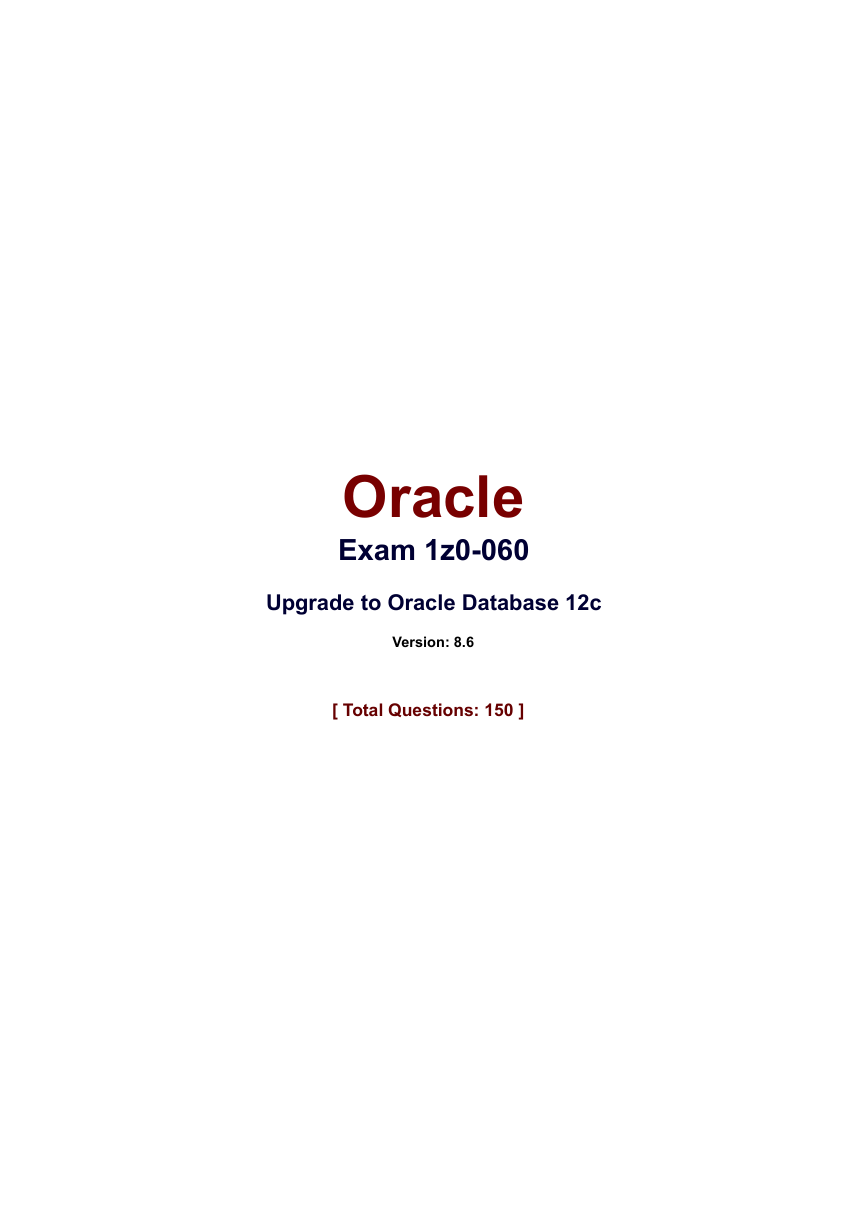
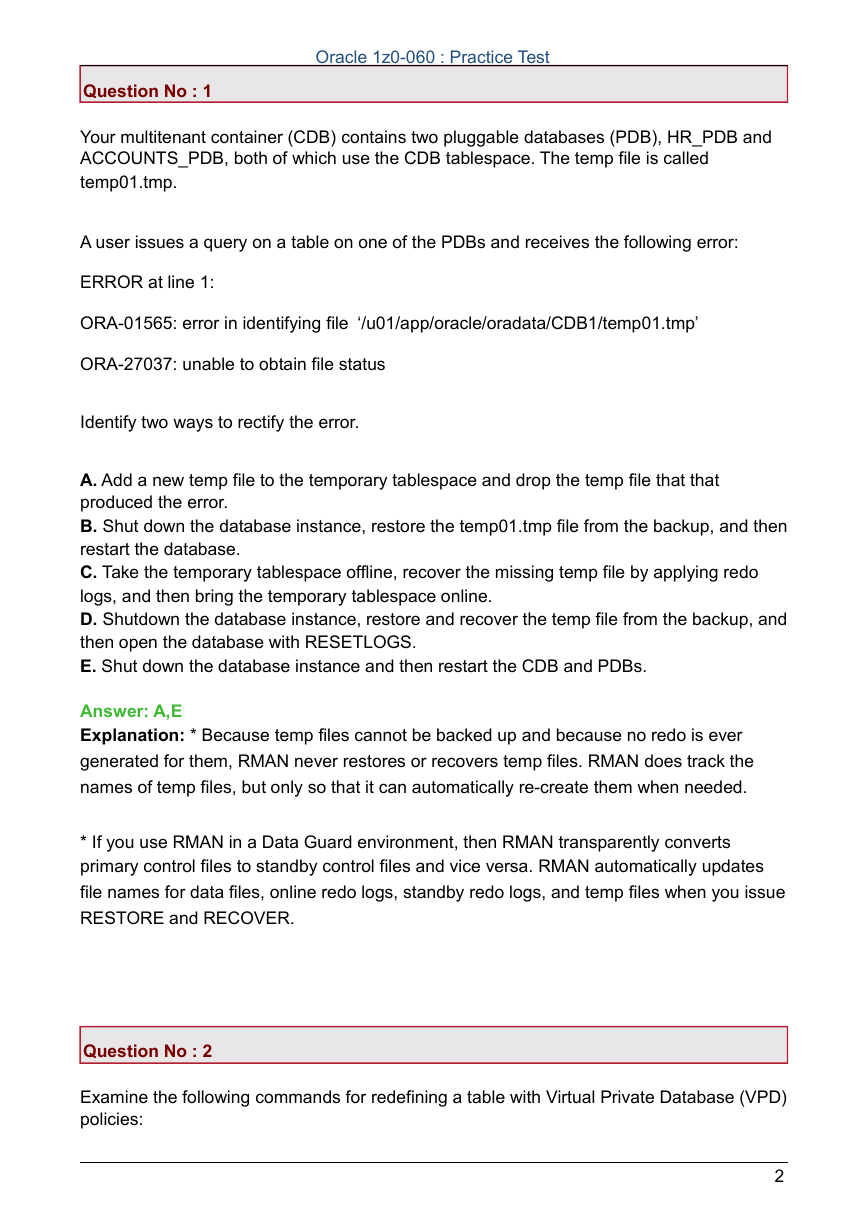
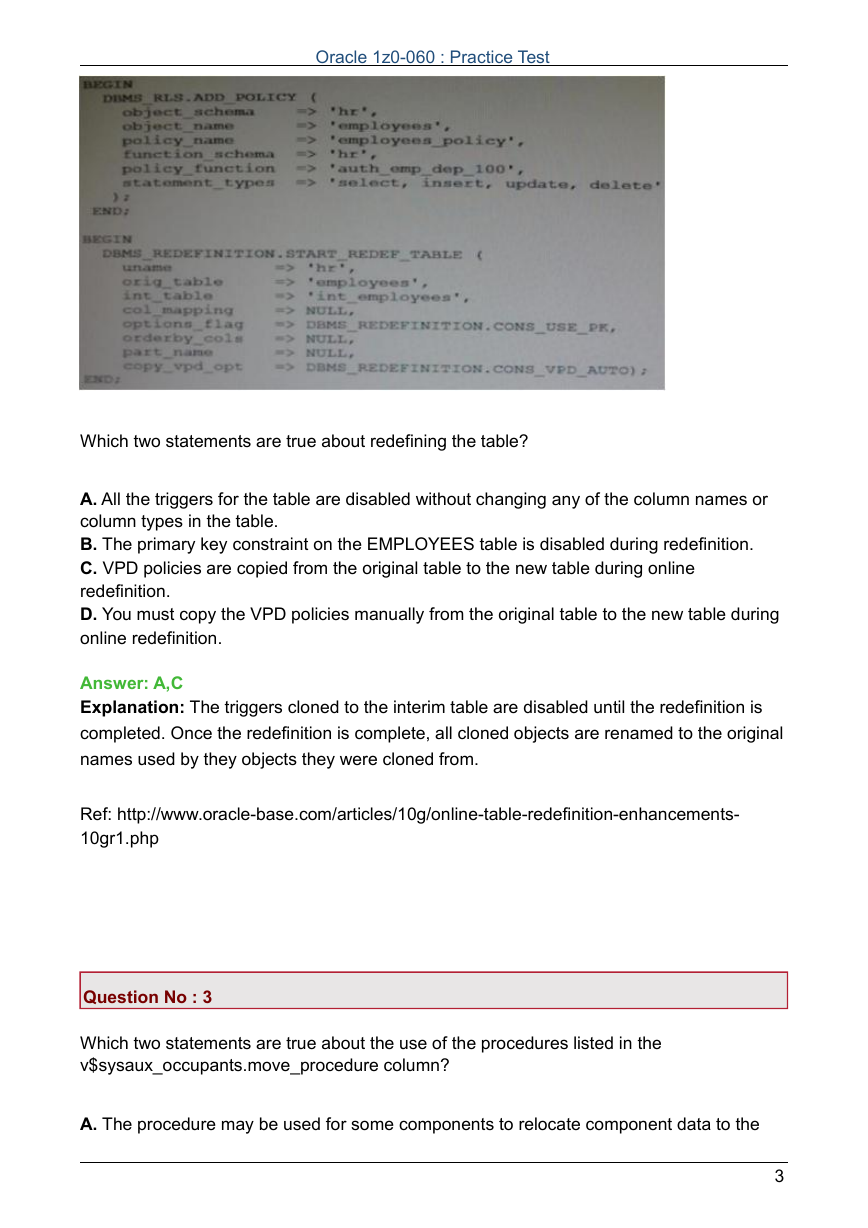
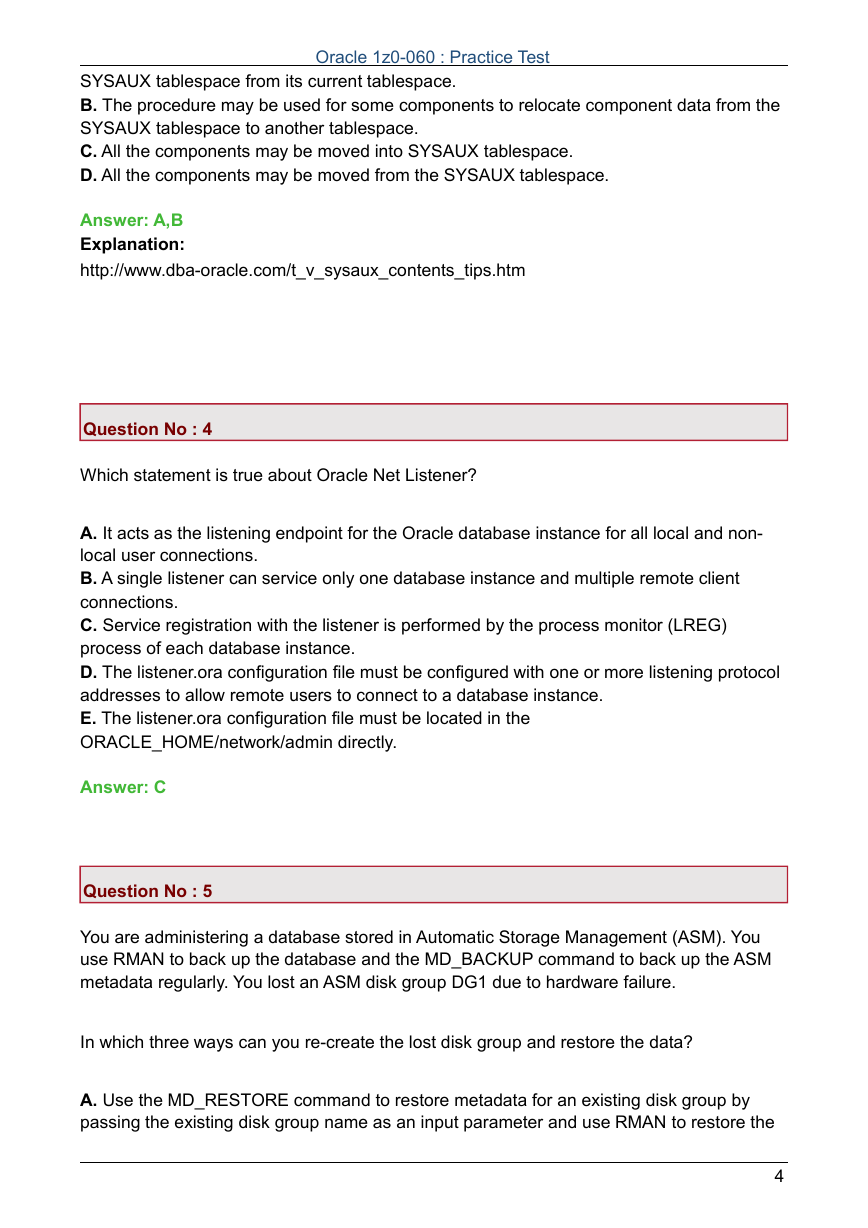
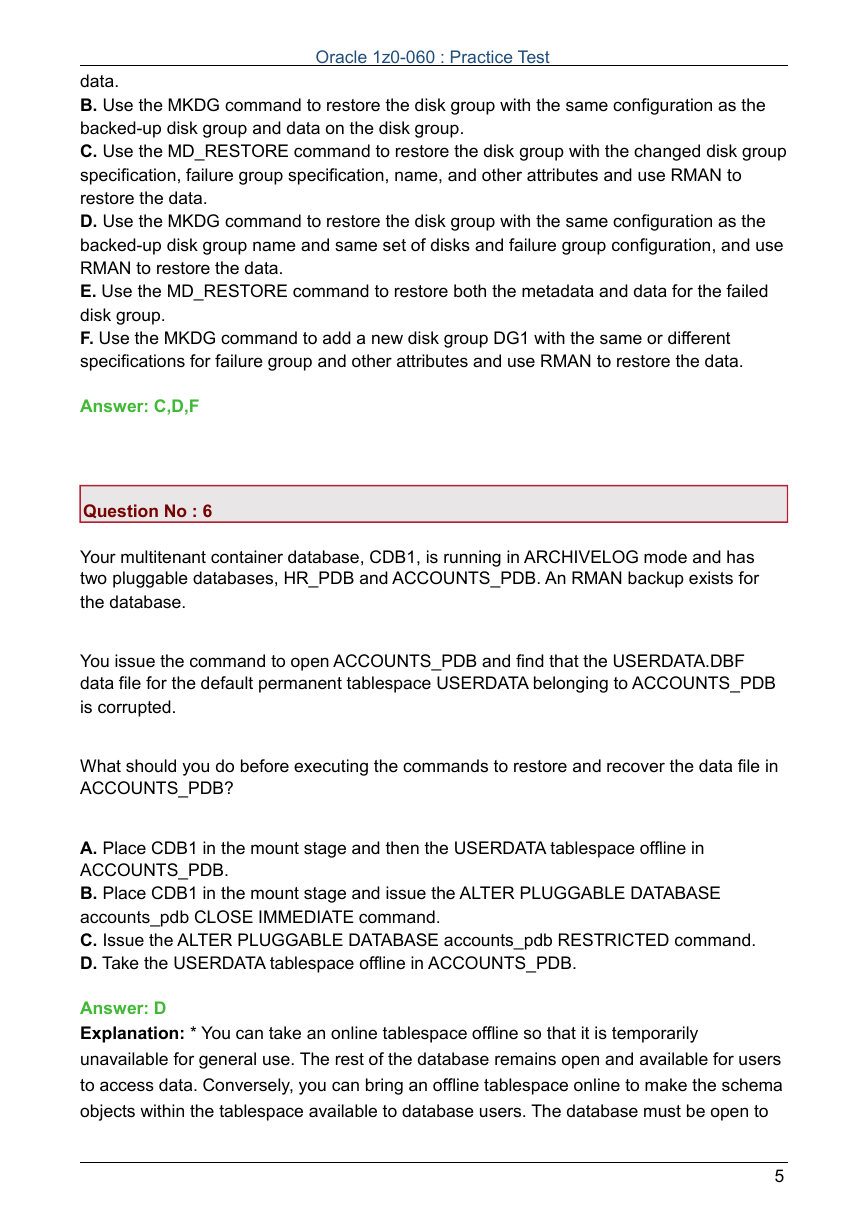

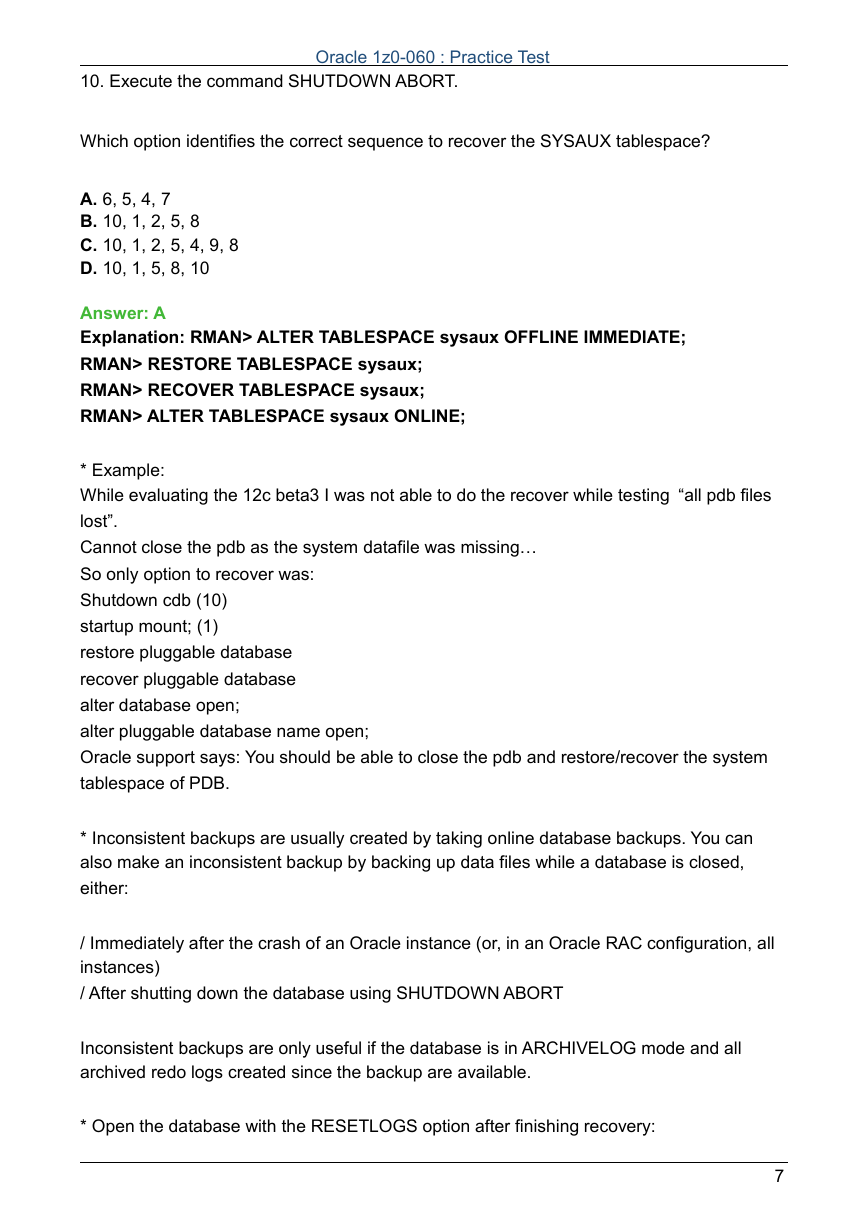









 2023年江西萍乡中考道德与法治真题及答案.doc
2023年江西萍乡中考道德与法治真题及答案.doc 2012年重庆南川中考生物真题及答案.doc
2012年重庆南川中考生物真题及答案.doc 2013年江西师范大学地理学综合及文艺理论基础考研真题.doc
2013年江西师范大学地理学综合及文艺理论基础考研真题.doc 2020年四川甘孜小升初语文真题及答案I卷.doc
2020年四川甘孜小升初语文真题及答案I卷.doc 2020年注册岩土工程师专业基础考试真题及答案.doc
2020年注册岩土工程师专业基础考试真题及答案.doc 2023-2024学年福建省厦门市九年级上学期数学月考试题及答案.doc
2023-2024学年福建省厦门市九年级上学期数学月考试题及答案.doc 2021-2022学年辽宁省沈阳市大东区九年级上学期语文期末试题及答案.doc
2021-2022学年辽宁省沈阳市大东区九年级上学期语文期末试题及答案.doc 2022-2023学年北京东城区初三第一学期物理期末试卷及答案.doc
2022-2023学年北京东城区初三第一学期物理期末试卷及答案.doc 2018上半年江西教师资格初中地理学科知识与教学能力真题及答案.doc
2018上半年江西教师资格初中地理学科知识与教学能力真题及答案.doc 2012年河北国家公务员申论考试真题及答案-省级.doc
2012年河北国家公务员申论考试真题及答案-省级.doc 2020-2021学年江苏省扬州市江都区邵樊片九年级上学期数学第一次质量检测试题及答案.doc
2020-2021学年江苏省扬州市江都区邵樊片九年级上学期数学第一次质量检测试题及答案.doc 2022下半年黑龙江教师资格证中学综合素质真题及答案.doc
2022下半年黑龙江教师资格证中学综合素质真题及答案.doc